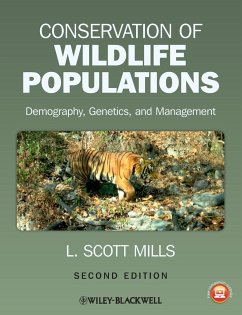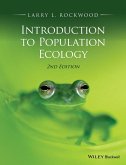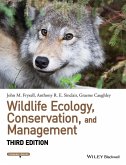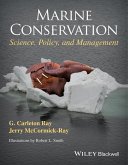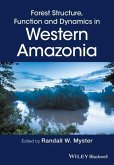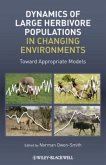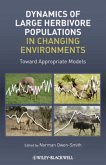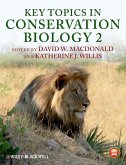- Broschiertes Buch
- Merkliste
- Auf die Merkliste
- Bewerten Bewerten
- Teilen
- Produkt teilen
- Produkterinnerung
- Produkterinnerung
Population ecology has matured to a sophisticated science with astonishing potential for contributing solutions to wildlife conservation and management challenges. And yet, much of the applied power of wildlife population ecology remains untapped because its broad sweep across disparate subfields has been isolated in specialized texts. In this book, L. Scott Mills covers the full spectrum of applied wildlife population ecology, including genomic tools for non-invasive genetic sampling, predation, population projections, climate change and invasive species, harvest modeling, viability analysis,…mehr
Andere Kunden interessierten sich auch für
![Introduction to Population Ecology Introduction to Population Ecology]() Larry L. RockwoodIntroduction to Population Ecology60,99 €
Larry L. RockwoodIntroduction to Population Ecology60,99 €![Wildlife Ecology, Conservation, and Management Wildlife Ecology, Conservation, and Management]() John M. FryxellWildlife Ecology, Conservation, and Management58,99 €
John M. FryxellWildlife Ecology, Conservation, and Management58,99 €![Marine Conservation Marine Conservation]() G. Carleton RayMarine Conservation92,99 €
G. Carleton RayMarine Conservation92,99 €![Forest Structure, Function and Dynamics in Western Amazonia Forest Structure, Function and Dynamics in Western Amazonia]() Forest Structure, Function and Dynamics in Western Amazonia139,99 €
Forest Structure, Function and Dynamics in Western Amazonia139,99 €![Dynamics of Large Herbivore Populations in Changing Environments Dynamics of Large Herbivore Populations in Changing Environments]() Norman Owen-SmithDynamics of Large Herbivore Populations in Changing Environments183,99 €
Norman Owen-SmithDynamics of Large Herbivore Populations in Changing Environments183,99 €![Dynamics of Large Herbivore Populations in Changing Environments Dynamics of Large Herbivore Populations in Changing Environments]() Norman Owen-SmithDynamics of Large Herbivore Populations in Changing Environments129,99 €
Norman Owen-SmithDynamics of Large Herbivore Populations in Changing Environments129,99 €![Key Topics in Conservation Biology 2 Key Topics in Conservation Biology 2]() Key Topics in Conservation Biology 2105,99 €
Key Topics in Conservation Biology 2105,99 €-
-
-
Population ecology has matured to a sophisticated science with astonishing potential for contributing solutions to wildlife conservation and management challenges. And yet, much of the applied power of wildlife population ecology remains untapped because its broad sweep across disparate subfields has been isolated in specialized texts. In this book, L. Scott Mills covers the full spectrum of applied wildlife population ecology, including genomic tools for non-invasive genetic sampling, predation, population projections, climate change and invasive species, harvest modeling, viability analysis, focal species concepts, and analyses of connectivity in fragmented landscapes. With a readable style, analytical rigor, and hundreds of examples drawn from around the world, Conservation of Wildlife Populations (2nd ed) provides the conceptual basis for applying population ecology to wildlife conservation decision-making. Although targeting primarily undergraduates and beginning graduate students with some basic training in basic ecology and statistics (in majors that could include wildlife biology, conservation biology, ecology, environmental studies, and biology), the book will also be useful for practitioners in the field who want to find - in one place and with plenty of applied examples - the latest advances in the genetic and demographic aspects of population ecology.
Additional resources for this book can be found at: www.wiley.com/go/mills/wildlifepopulations.
Hinweis: Dieser Artikel kann nur an eine deutsche Lieferadresse ausgeliefert werden.
Additional resources for this book can be found at: www.wiley.com/go/mills/wildlifepopulations.
Hinweis: Dieser Artikel kann nur an eine deutsche Lieferadresse ausgeliefert werden.
Produktdetails
- Produktdetails
- Verlag: Wiley & Sons
- 2. Aufl.
- Seitenzahl: 352
- Erscheinungstermin: 23. November 2012
- Englisch
- Abmessung: 246mm x 189mm x 19mm
- Gewicht: 775g
- ISBN-13: 9780470671498
- ISBN-10: 0470671491
- Artikelnr.: 36519422
- Herstellerkennzeichnung
- Libri GmbH
- Europaallee 1
- 36244 Bad Hersfeld
- gpsr@libri.de
- Verlag: Wiley & Sons
- 2. Aufl.
- Seitenzahl: 352
- Erscheinungstermin: 23. November 2012
- Englisch
- Abmessung: 246mm x 189mm x 19mm
- Gewicht: 775g
- ISBN-13: 9780470671498
- ISBN-10: 0470671491
- Artikelnr.: 36519422
- Herstellerkennzeichnung
- Libri GmbH
- Europaallee 1
- 36244 Bad Hersfeld
- gpsr@libri.de
L. Scott Mills is a Professor in the Wildlife Biology Program at The University of Montana. He was a 2009 John Simon Guggenheim Fellow, has received multiple NSF Awards, served on the Board of Governors for the North American Section of the Society for Conservation Biology, and has testified to Congress about the role of ethics in wildlife population biology research. Mills was an invited contributor to the 2007 Intergovernmental Panel on Climate Change Report (IPCC) report, and to the Western Governors¿ Association Climate Change Working Group. His research and teaching integrates field studies with population models and genetic analyses to understand effects of human perturbations on wildlife populations. Mills' research on wildlife around the world ? from snowshoe hares to marmots, mice to coyotes, bighorn sheep to snow leopards and tigers - has been covered in media outlets including Newsweek, National Geographic, The New York Times, Discovery Channel Canada, Science News, National Public Radio, Nature, Science, and The Nature of Things with David Suzuki.
List of boxes ix
Preface to second edition xi
Preface to first edition xii
List of symbols xiv
Acknowledgments for second edition xv
Acknowledgments for first edition xvi
Part I Background To Applied Population Biology 1
1 The Big Picture: Human Population Dynamics Meet Applied Population
Biology 3
Introduction 3
Population Ecology of Humans 4
Extinction Rates of Other Species 8
Humans and Sustainable Harvest 12
The Big Picture 13
Further Reading 13
2 Designing Studies and Interpreting Population Biology Data: How Do We
Know What We Know? 14
Introduction 14
Obtaining Reliable Facts Through Sampling 15
Linking Observed Facts to Ideasmind Leads to Understanding 19
Ethics and the Wildlife Population Biologist 29
Summary 31
Further Reading 32
3 Genetic Concepts and Tools To Support Wildlife Population Biology 33
Introduction 33
What Is Genetic Variation? 33
Genetic Markers Used in Wildlife Population Biology 35
Insights into Wildlife Population Biology Using Genetic Tools 43
Summary 52
Further Reading 53
4 Estimating Population Vital Rates 54
Introduction 54
Estimating Abundance and Density 54
Survival Estimation 67
Estimation of Reproduction 70
Sex Ratio 71
Summary 74
Further Reading 75
Part II Population Processes: The Basis For Management 77
5 The Simplest Way To Describe And Project Population Growth: Exponential
or Geometric Change 79
Introduction 79
Fundamentals of Geometric or Exponential Growth 80
Causes and Consequences of Variation in Population Growth 84
Quantifying Exponential Population Growth in a Stochastic Environment 91
Summary 96
Further Reading 97
6 All Stage Classes Are Not Equal In Their Effects On Population Growth:
Structured Population-Projection Models 98
Introduction 98
Anatomy of a Population-Projection Matrix 99
How Timing of Sampling Affects the Matrix 100
Projecting a Matrix Through Time Leads to Transient and Asymptotic Dynamics
103
All Vital Rates are not Created Equal: Analytical Sensitivities and
Elasticities 108
Stochasticity in Age and Stage-Structured Populations 109
Sensitivity Analysis in the Broad Sense to Help Evaluate Management Actions
113
Fitness is Lambda, Selection is Management 116
Case Studies Using Matrix Models to Guide Conservation Decision-Making 118
Summary 124
Further Reading 125
7 Density-Dependent Population Change 126
Introduction 126
Negative Density Dependence 126
The Logistic: One Simple Model of Negative Density-Dependent Population
Growth 128
Some Counterintuitive Dynamics: Limit Cycles and Chaos 133
Positive Density Dependence 135
Negative and Positive Density Dependence Operate Together 138
Component Versus Demographic Outcomes of Density Dependence 140
Summary 140
Further Reading 141
8 Predation and Wildlife Populations 142
Introduction 142
Does Predation Affect Prey Numbers? 143
Factor 1. Determining How Predation Affects Prey Numbers: Predation Rate
145
Factor 2. Determining How Predation Affects Prey Numbers: Compensation 150
Factor 3. Determining How Predation Affects Prey Numbers: Who Gets Killed
152
Summary 152
Further Reading 153
9 Genetic Variation and Fitness In Wildlife Populations 154
Introduction 154
Long-Term Benefits of Genetic Variation 154
What Determines Levels of Genetic Variation in Populations? 155
Quantifying the Loss of Heterozygosity: The Inbreeding Coefficient 161
When Does Inbreeding Due to Genetic Drift Lead to Inbreeding Depression?
162
Outbreeding Depression and the Loss of Local Adaptation 165
Genetic Rescue, Genetic Restoration, and Long-Term Population Recovery 167
Appropriate Levels of Genetic Connectivity 168
Case Studies Where Genetic Rescue Meets the Real World 169
Summary 173
Further Reading 174
10 Dynamics of Multiple Populations 175
Introduction 175
What Is Connectivity? 176
Consequences of Connectivity for Wildlife Populations 177
Measuring Connectivity Among Wildlife Populations 177
Multiple Populations are not All Equal 185
Options for Restoring Connectivity 194
Summary 197
Further Reading 198
Part III Applying Knowledge of Population Processes To Problems of
Declining, Small, or Harvestable Populations 199
11 Human-Caused Stressors: Deterministic Factors Affecting Populations 201
Introduction 201
General Effects of Deterministic Stressors on Populations: Adapt, Move, or
Die 201
Habitat Loss and Fragmentation 203
Introduced and Invasive Species 206
Pollution 212
Overharvest 214
Global Climate Change 215
Multiple Deterministic Stressors Occur Simultaneously 220
Summary 222
Further Reading 223
12 Predicting The Dynamics of Small and Declining Populations 224
Introduction 224
Ecological Characteristics Predicting Risk 224
The Extinction Vortex 226
Predicting Risks in Small Populations 226
Population Viability Analysis (PVA): Quantitative Methods of Assessing
Viability 227
Other Approaches to Assessing Viability 239
Summary 242
Further Reading 243
13 Focal Species To Bridge From Populations To Ecosystems 244
Introduction 244
The Four Categories of Focal Species 245
Summary 249
Further Reading 250
14 Population Biology To Guide Sustainable Harvest 251
Introduction 251
Effects of Hunting on Population Dynamics 252
Long-Term Effects: Hunting as an Evolutionary Force 257
Models to Guide Sustainable Harvest 258
Waterfowl Harvest and Adaptive Harvest Management in the US 264
Management of Overabundant and Pest Populations 265
Summary 266
Further Reading 267
Epilogue 269
References 271
Index 301
Preface to second edition xi
Preface to first edition xii
List of symbols xiv
Acknowledgments for second edition xv
Acknowledgments for first edition xvi
Part I Background To Applied Population Biology 1
1 The Big Picture: Human Population Dynamics Meet Applied Population
Biology 3
Introduction 3
Population Ecology of Humans 4
Extinction Rates of Other Species 8
Humans and Sustainable Harvest 12
The Big Picture 13
Further Reading 13
2 Designing Studies and Interpreting Population Biology Data: How Do We
Know What We Know? 14
Introduction 14
Obtaining Reliable Facts Through Sampling 15
Linking Observed Facts to Ideasmind Leads to Understanding 19
Ethics and the Wildlife Population Biologist 29
Summary 31
Further Reading 32
3 Genetic Concepts and Tools To Support Wildlife Population Biology 33
Introduction 33
What Is Genetic Variation? 33
Genetic Markers Used in Wildlife Population Biology 35
Insights into Wildlife Population Biology Using Genetic Tools 43
Summary 52
Further Reading 53
4 Estimating Population Vital Rates 54
Introduction 54
Estimating Abundance and Density 54
Survival Estimation 67
Estimation of Reproduction 70
Sex Ratio 71
Summary 74
Further Reading 75
Part II Population Processes: The Basis For Management 77
5 The Simplest Way To Describe And Project Population Growth: Exponential
or Geometric Change 79
Introduction 79
Fundamentals of Geometric or Exponential Growth 80
Causes and Consequences of Variation in Population Growth 84
Quantifying Exponential Population Growth in a Stochastic Environment 91
Summary 96
Further Reading 97
6 All Stage Classes Are Not Equal In Their Effects On Population Growth:
Structured Population-Projection Models 98
Introduction 98
Anatomy of a Population-Projection Matrix 99
How Timing of Sampling Affects the Matrix 100
Projecting a Matrix Through Time Leads to Transient and Asymptotic Dynamics
103
All Vital Rates are not Created Equal: Analytical Sensitivities and
Elasticities 108
Stochasticity in Age and Stage-Structured Populations 109
Sensitivity Analysis in the Broad Sense to Help Evaluate Management Actions
113
Fitness is Lambda, Selection is Management 116
Case Studies Using Matrix Models to Guide Conservation Decision-Making 118
Summary 124
Further Reading 125
7 Density-Dependent Population Change 126
Introduction 126
Negative Density Dependence 126
The Logistic: One Simple Model of Negative Density-Dependent Population
Growth 128
Some Counterintuitive Dynamics: Limit Cycles and Chaos 133
Positive Density Dependence 135
Negative and Positive Density Dependence Operate Together 138
Component Versus Demographic Outcomes of Density Dependence 140
Summary 140
Further Reading 141
8 Predation and Wildlife Populations 142
Introduction 142
Does Predation Affect Prey Numbers? 143
Factor 1. Determining How Predation Affects Prey Numbers: Predation Rate
145
Factor 2. Determining How Predation Affects Prey Numbers: Compensation 150
Factor 3. Determining How Predation Affects Prey Numbers: Who Gets Killed
152
Summary 152
Further Reading 153
9 Genetic Variation and Fitness In Wildlife Populations 154
Introduction 154
Long-Term Benefits of Genetic Variation 154
What Determines Levels of Genetic Variation in Populations? 155
Quantifying the Loss of Heterozygosity: The Inbreeding Coefficient 161
When Does Inbreeding Due to Genetic Drift Lead to Inbreeding Depression?
162
Outbreeding Depression and the Loss of Local Adaptation 165
Genetic Rescue, Genetic Restoration, and Long-Term Population Recovery 167
Appropriate Levels of Genetic Connectivity 168
Case Studies Where Genetic Rescue Meets the Real World 169
Summary 173
Further Reading 174
10 Dynamics of Multiple Populations 175
Introduction 175
What Is Connectivity? 176
Consequences of Connectivity for Wildlife Populations 177
Measuring Connectivity Among Wildlife Populations 177
Multiple Populations are not All Equal 185
Options for Restoring Connectivity 194
Summary 197
Further Reading 198
Part III Applying Knowledge of Population Processes To Problems of
Declining, Small, or Harvestable Populations 199
11 Human-Caused Stressors: Deterministic Factors Affecting Populations 201
Introduction 201
General Effects of Deterministic Stressors on Populations: Adapt, Move, or
Die 201
Habitat Loss and Fragmentation 203
Introduced and Invasive Species 206
Pollution 212
Overharvest 214
Global Climate Change 215
Multiple Deterministic Stressors Occur Simultaneously 220
Summary 222
Further Reading 223
12 Predicting The Dynamics of Small and Declining Populations 224
Introduction 224
Ecological Characteristics Predicting Risk 224
The Extinction Vortex 226
Predicting Risks in Small Populations 226
Population Viability Analysis (PVA): Quantitative Methods of Assessing
Viability 227
Other Approaches to Assessing Viability 239
Summary 242
Further Reading 243
13 Focal Species To Bridge From Populations To Ecosystems 244
Introduction 244
The Four Categories of Focal Species 245
Summary 249
Further Reading 250
14 Population Biology To Guide Sustainable Harvest 251
Introduction 251
Effects of Hunting on Population Dynamics 252
Long-Term Effects: Hunting as an Evolutionary Force 257
Models to Guide Sustainable Harvest 258
Waterfowl Harvest and Adaptive Harvest Management in the US 264
Management of Overabundant and Pest Populations 265
Summary 266
Further Reading 267
Epilogue 269
References 271
Index 301
List of boxes ix
Preface to second edition xi
Preface to first edition xii
List of symbols xiv
Acknowledgments for second edition xv
Acknowledgments for first edition xvi
Part I Background To Applied Population Biology 1
1 The Big Picture: Human Population Dynamics Meet Applied Population
Biology 3
Introduction 3
Population Ecology of Humans 4
Extinction Rates of Other Species 8
Humans and Sustainable Harvest 12
The Big Picture 13
Further Reading 13
2 Designing Studies and Interpreting Population Biology Data: How Do We
Know What We Know? 14
Introduction 14
Obtaining Reliable Facts Through Sampling 15
Linking Observed Facts to Ideasmind Leads to Understanding 19
Ethics and the Wildlife Population Biologist 29
Summary 31
Further Reading 32
3 Genetic Concepts and Tools To Support Wildlife Population Biology 33
Introduction 33
What Is Genetic Variation? 33
Genetic Markers Used in Wildlife Population Biology 35
Insights into Wildlife Population Biology Using Genetic Tools 43
Summary 52
Further Reading 53
4 Estimating Population Vital Rates 54
Introduction 54
Estimating Abundance and Density 54
Survival Estimation 67
Estimation of Reproduction 70
Sex Ratio 71
Summary 74
Further Reading 75
Part II Population Processes: The Basis For Management 77
5 The Simplest Way To Describe And Project Population Growth: Exponential
or Geometric Change 79
Introduction 79
Fundamentals of Geometric or Exponential Growth 80
Causes and Consequences of Variation in Population Growth 84
Quantifying Exponential Population Growth in a Stochastic Environment 91
Summary 96
Further Reading 97
6 All Stage Classes Are Not Equal In Their Effects On Population Growth:
Structured Population-Projection Models 98
Introduction 98
Anatomy of a Population-Projection Matrix 99
How Timing of Sampling Affects the Matrix 100
Projecting a Matrix Through Time Leads to Transient and Asymptotic Dynamics
103
All Vital Rates are not Created Equal: Analytical Sensitivities and
Elasticities 108
Stochasticity in Age and Stage-Structured Populations 109
Sensitivity Analysis in the Broad Sense to Help Evaluate Management Actions
113
Fitness is Lambda, Selection is Management 116
Case Studies Using Matrix Models to Guide Conservation Decision-Making 118
Summary 124
Further Reading 125
7 Density-Dependent Population Change 126
Introduction 126
Negative Density Dependence 126
The Logistic: One Simple Model of Negative Density-Dependent Population
Growth 128
Some Counterintuitive Dynamics: Limit Cycles and Chaos 133
Positive Density Dependence 135
Negative and Positive Density Dependence Operate Together 138
Component Versus Demographic Outcomes of Density Dependence 140
Summary 140
Further Reading 141
8 Predation and Wildlife Populations 142
Introduction 142
Does Predation Affect Prey Numbers? 143
Factor 1. Determining How Predation Affects Prey Numbers: Predation Rate
145
Factor 2. Determining How Predation Affects Prey Numbers: Compensation 150
Factor 3. Determining How Predation Affects Prey Numbers: Who Gets Killed
152
Summary 152
Further Reading 153
9 Genetic Variation and Fitness In Wildlife Populations 154
Introduction 154
Long-Term Benefits of Genetic Variation 154
What Determines Levels of Genetic Variation in Populations? 155
Quantifying the Loss of Heterozygosity: The Inbreeding Coefficient 161
When Does Inbreeding Due to Genetic Drift Lead to Inbreeding Depression?
162
Outbreeding Depression and the Loss of Local Adaptation 165
Genetic Rescue, Genetic Restoration, and Long-Term Population Recovery 167
Appropriate Levels of Genetic Connectivity 168
Case Studies Where Genetic Rescue Meets the Real World 169
Summary 173
Further Reading 174
10 Dynamics of Multiple Populations 175
Introduction 175
What Is Connectivity? 176
Consequences of Connectivity for Wildlife Populations 177
Measuring Connectivity Among Wildlife Populations 177
Multiple Populations are not All Equal 185
Options for Restoring Connectivity 194
Summary 197
Further Reading 198
Part III Applying Knowledge of Population Processes To Problems of
Declining, Small, or Harvestable Populations 199
11 Human-Caused Stressors: Deterministic Factors Affecting Populations 201
Introduction 201
General Effects of Deterministic Stressors on Populations: Adapt, Move, or
Die 201
Habitat Loss and Fragmentation 203
Introduced and Invasive Species 206
Pollution 212
Overharvest 214
Global Climate Change 215
Multiple Deterministic Stressors Occur Simultaneously 220
Summary 222
Further Reading 223
12 Predicting The Dynamics of Small and Declining Populations 224
Introduction 224
Ecological Characteristics Predicting Risk 224
The Extinction Vortex 226
Predicting Risks in Small Populations 226
Population Viability Analysis (PVA): Quantitative Methods of Assessing
Viability 227
Other Approaches to Assessing Viability 239
Summary 242
Further Reading 243
13 Focal Species To Bridge From Populations To Ecosystems 244
Introduction 244
The Four Categories of Focal Species 245
Summary 249
Further Reading 250
14 Population Biology To Guide Sustainable Harvest 251
Introduction 251
Effects of Hunting on Population Dynamics 252
Long-Term Effects: Hunting as an Evolutionary Force 257
Models to Guide Sustainable Harvest 258
Waterfowl Harvest and Adaptive Harvest Management in the US 264
Management of Overabundant and Pest Populations 265
Summary 266
Further Reading 267
Epilogue 269
References 271
Index 301
Preface to second edition xi
Preface to first edition xii
List of symbols xiv
Acknowledgments for second edition xv
Acknowledgments for first edition xvi
Part I Background To Applied Population Biology 1
1 The Big Picture: Human Population Dynamics Meet Applied Population
Biology 3
Introduction 3
Population Ecology of Humans 4
Extinction Rates of Other Species 8
Humans and Sustainable Harvest 12
The Big Picture 13
Further Reading 13
2 Designing Studies and Interpreting Population Biology Data: How Do We
Know What We Know? 14
Introduction 14
Obtaining Reliable Facts Through Sampling 15
Linking Observed Facts to Ideasmind Leads to Understanding 19
Ethics and the Wildlife Population Biologist 29
Summary 31
Further Reading 32
3 Genetic Concepts and Tools To Support Wildlife Population Biology 33
Introduction 33
What Is Genetic Variation? 33
Genetic Markers Used in Wildlife Population Biology 35
Insights into Wildlife Population Biology Using Genetic Tools 43
Summary 52
Further Reading 53
4 Estimating Population Vital Rates 54
Introduction 54
Estimating Abundance and Density 54
Survival Estimation 67
Estimation of Reproduction 70
Sex Ratio 71
Summary 74
Further Reading 75
Part II Population Processes: The Basis For Management 77
5 The Simplest Way To Describe And Project Population Growth: Exponential
or Geometric Change 79
Introduction 79
Fundamentals of Geometric or Exponential Growth 80
Causes and Consequences of Variation in Population Growth 84
Quantifying Exponential Population Growth in a Stochastic Environment 91
Summary 96
Further Reading 97
6 All Stage Classes Are Not Equal In Their Effects On Population Growth:
Structured Population-Projection Models 98
Introduction 98
Anatomy of a Population-Projection Matrix 99
How Timing of Sampling Affects the Matrix 100
Projecting a Matrix Through Time Leads to Transient and Asymptotic Dynamics
103
All Vital Rates are not Created Equal: Analytical Sensitivities and
Elasticities 108
Stochasticity in Age and Stage-Structured Populations 109
Sensitivity Analysis in the Broad Sense to Help Evaluate Management Actions
113
Fitness is Lambda, Selection is Management 116
Case Studies Using Matrix Models to Guide Conservation Decision-Making 118
Summary 124
Further Reading 125
7 Density-Dependent Population Change 126
Introduction 126
Negative Density Dependence 126
The Logistic: One Simple Model of Negative Density-Dependent Population
Growth 128
Some Counterintuitive Dynamics: Limit Cycles and Chaos 133
Positive Density Dependence 135
Negative and Positive Density Dependence Operate Together 138
Component Versus Demographic Outcomes of Density Dependence 140
Summary 140
Further Reading 141
8 Predation and Wildlife Populations 142
Introduction 142
Does Predation Affect Prey Numbers? 143
Factor 1. Determining How Predation Affects Prey Numbers: Predation Rate
145
Factor 2. Determining How Predation Affects Prey Numbers: Compensation 150
Factor 3. Determining How Predation Affects Prey Numbers: Who Gets Killed
152
Summary 152
Further Reading 153
9 Genetic Variation and Fitness In Wildlife Populations 154
Introduction 154
Long-Term Benefits of Genetic Variation 154
What Determines Levels of Genetic Variation in Populations? 155
Quantifying the Loss of Heterozygosity: The Inbreeding Coefficient 161
When Does Inbreeding Due to Genetic Drift Lead to Inbreeding Depression?
162
Outbreeding Depression and the Loss of Local Adaptation 165
Genetic Rescue, Genetic Restoration, and Long-Term Population Recovery 167
Appropriate Levels of Genetic Connectivity 168
Case Studies Where Genetic Rescue Meets the Real World 169
Summary 173
Further Reading 174
10 Dynamics of Multiple Populations 175
Introduction 175
What Is Connectivity? 176
Consequences of Connectivity for Wildlife Populations 177
Measuring Connectivity Among Wildlife Populations 177
Multiple Populations are not All Equal 185
Options for Restoring Connectivity 194
Summary 197
Further Reading 198
Part III Applying Knowledge of Population Processes To Problems of
Declining, Small, or Harvestable Populations 199
11 Human-Caused Stressors: Deterministic Factors Affecting Populations 201
Introduction 201
General Effects of Deterministic Stressors on Populations: Adapt, Move, or
Die 201
Habitat Loss and Fragmentation 203
Introduced and Invasive Species 206
Pollution 212
Overharvest 214
Global Climate Change 215
Multiple Deterministic Stressors Occur Simultaneously 220
Summary 222
Further Reading 223
12 Predicting The Dynamics of Small and Declining Populations 224
Introduction 224
Ecological Characteristics Predicting Risk 224
The Extinction Vortex 226
Predicting Risks in Small Populations 226
Population Viability Analysis (PVA): Quantitative Methods of Assessing
Viability 227
Other Approaches to Assessing Viability 239
Summary 242
Further Reading 243
13 Focal Species To Bridge From Populations To Ecosystems 244
Introduction 244
The Four Categories of Focal Species 245
Summary 249
Further Reading 250
14 Population Biology To Guide Sustainable Harvest 251
Introduction 251
Effects of Hunting on Population Dynamics 252
Long-Term Effects: Hunting as an Evolutionary Force 257
Models to Guide Sustainable Harvest 258
Waterfowl Harvest and Adaptive Harvest Management in the US 264
Management of Overabundant and Pest Populations 265
Summary 266
Further Reading 267
Epilogue 269
References 271
Index 301

